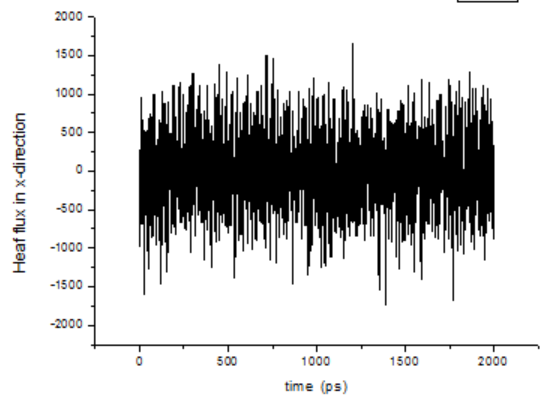Hi all,
The description of compute heat/flux says “This can be used by itself to measure the heat flux into or out of a reservoir of atoms”. I just wonder how can I do this. For example: the bilayer graphene with hot/cold reservoirs on both ends. The langevin thermostats are used. I wish to find out the amount of heat going through each layer separately (although they are supposed to be the same) so that I set two of this compute commands on the hot reservoirs for both layers after a steady T gradient is formed. But what I got is (for one of the two layers): The heat flux is in the x-direction

It oscillates around zero instead of being greater than 0 all the time. I don’t know how to process or if it is a proper way to do this.
Otherwise, I just wonder if I can use four langevin thermostats to control the temperature of the hot/cold reservoirs of the two layers so that the heat pass through two layers can be easily found.
Many thanks in advance!
Sincerely,
Yuan Gao
Hi all,
The description of compute heat/flux says "This can be used by itself to
measure the heat flux into or out of a reservoir of atoms". I just wonder
how can I do this. For example: the bilayer graphene with hot/cold
reservoirs on both ends. The langevin thermostats are used. I wish to find
out the amount of heat going through each layer separately (although they
are supposed to be the same) so that I set two of this compute commands on
the hot reservoirs for both layers after a steady T gradient is formed. But
what I got is (for one of the two layers): The
heat flux is in the x-direction
!image.png|551x399
It oscillates around zero instead of being greater than 0 all the time. I
don't know how to process or if it is a proper way to do this.
Otherwise, I just wonder if I can use four langevin thermostats to control
the temperature of the hot/cold reservoirs of the two layers so that the
heat pass through two layers can be easily found.
rather than describing a rather complex production simulation setup, why
don't you first start with setting up a simplified test system based on
existing examples and then see, if you can observe the same unexpected
behavior. if yes, you can post that simplified test here and there is a
chance that people can have a look at it and perhaps spot the problem.
speculating about what could have gone wrong rather useless with an unknown
input, knowing nothing about your level of experience and the correctness
of the input outside of the heat/flux computation.
axel.
